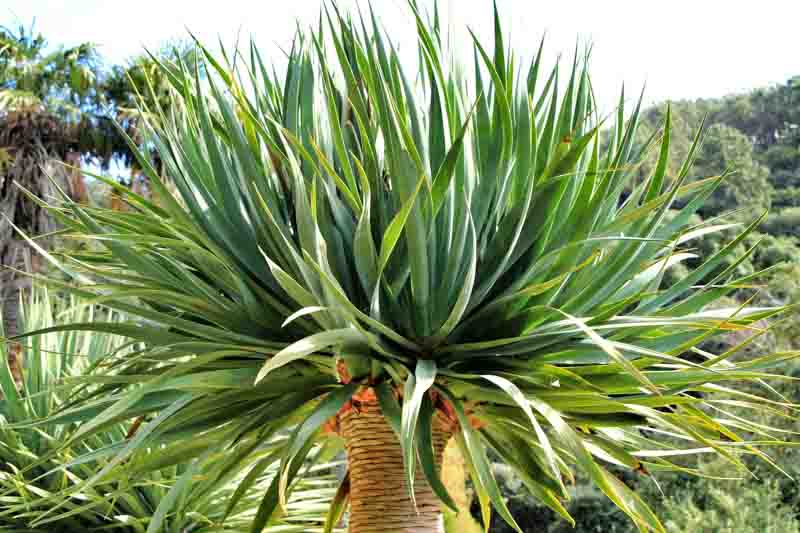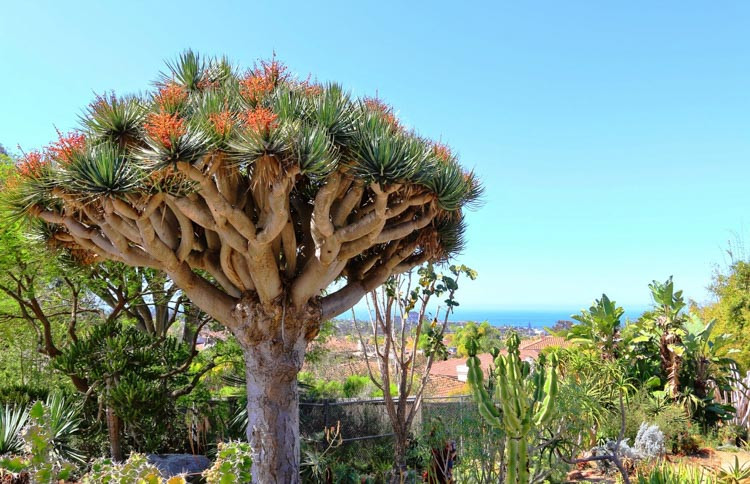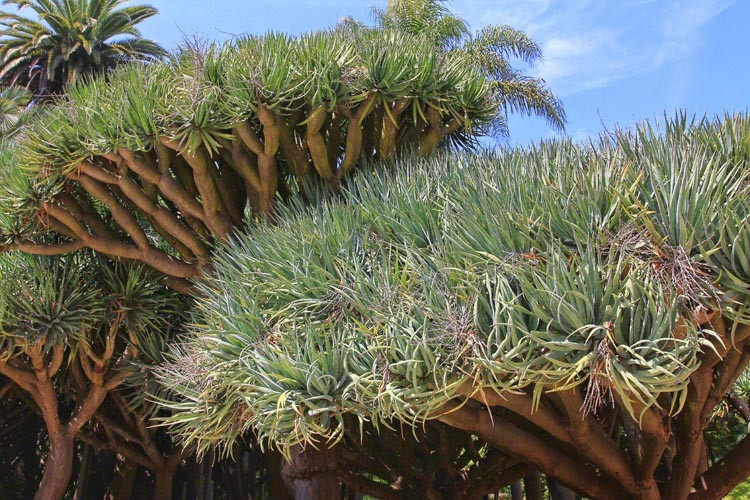Dragon Tree, Dragon Blood Tree, Asparagus draco
Dracaena draco, commonly known as the Dragon Tree, is an iconic and visually striking plant with a unique appearance and a rich history. It is renowned for its sculptural beauty, longevity, and resilience, making it a fascinating subject of both botanical interest and landscape design.
The Dragon Tree is characterized by its umbrella-like canopy, supported by a thick, singular trunk that branches out with age. The bark is smooth and gray, resembling elephant skin. Its leaves are long, narrow, and sword-shaped, arranged in rosettes at the branch tips, with a deep green color that can turn bluish-green under full sun exposure.
Native: This species is native to the Canary Islands, Cape Verde, Madeira, and locally in western Morocco. It has adapted to thrive in the subtropical climates of these regions. It belongs to the asparagus family (Asparagaceae), along with agaves and hostas.
Plant Type and Habit: Dracaena draco is a slow-growing, evergreen tree with a thick, swollen, cylindrical trunk that eventually branches out after flowering, creating a distinct, umbrella-like shape. Its stout, upright limbs boast terminal rosettes of sword-shaped, blue-green leaves. This ornamental tree does not begin to branch until it has flowered for the first time, usually after a few decades of growth.
Size: Over many years, Dracaena draco can grow 20 to 25 feet tall (6 to 7.5 meters) or more. In some rare instances, particularly in its native environment or other optimal conditions, it can reach heights of up to 50 to 60 feet (15 to 18 meters) over several decades. The tree has a broad, umbrella-like canopy that can spread widely, typically ranging from 20 to 30 feet (6 to 9 meters) across when fully mature.
Longevity: Dracaena draco can live for hundreds of years, with some specimens reportedly over a thousand years old.
Flowers: The Dragon Tree produces small, white, or greenish-white flowers arranged in dense, branched clusters. The flowers are fragrant and appear on mature trees, typically older than ten years. Flowering occurs in summer, although the tree may not bloom every year. The flowers give way to orange or red berries containing a single seed. The berries are attractive to birds, which help in seed dispersal.
Foliage: The foliage consists of rigid, sword-shaped leaves that can grow up to 24 inches long (60 cm). The leaves are a striking plant feature, creating a dense canopy.

Bark: Initially smooth and gray, the bark becomes scaly with horizontal, red stripes, a reminder that this tree bleeds crimson sap when the bark is cut or bruised. Likened to the blood of dragons (Dracaena means dragon in ancient Greek), this sap is used as a varnish for violins and other fine wood.
Hardiness: It is hardy in USDA zones 9 to 12 and requires protection from frost in cooler climates.
Award: Recipient of the prestigious Award of Garden Merit of the Royal Horticultural Society.
Uses: With its beautiful umbrella shape and palm-like appearance, it makes a dramatic focal point in the landscape. It is a good choice for coastal areas since it tolerates winds, salt spray, and salty soils. This succulent tree is commonly used as a houseplant. It is also valued for its resin, known as “dragon’s blood,” used in traditional medicine, dyes, and varnishes.
Wildlife: The tree provides habitat and food for various bird species, especially through its fruits, which are eaten and dispersed by birds.
Toxicity: Parts of the Dragon Tree are toxic if ingested, particularly to pets such as cats and dogs, causing symptoms like vomiting and diarrhea.
Deer and Rabbits: Dracaena draco is generally resistant to deer and rabbits due to its thick skin and high branches.
Drought / Salt Tolerance: The Dragon Tree is highly drought-tolerant once established, making it an excellent choice for xeriscaping and water-wise gardens. Its ability to adapt to salty conditions makes Dracaena draco a viable option for coastal landscapes and gardens where salty breezes or saltwater spray is common.
Invasiveness: Dracaena draco is not considered invasive. It grows slowly and is easily managed in cultivated landscapes.
Benefits: Beyond its ornamental value, the Dragon Tree is known for its air-purifying qualities, removing toxins from the environment and improving air quality indoors and out.
The Dragon Tree has been a symbol of power and resilience throughout history and is deeply embedded in the folklore and mythology of its native regions.
Growing Dracaena draco, or the Dragon Tree, indoors can add a dramatic and exotic element to your home décor. While it’s a slow-growing plant, it can thrive and become a long-lived indoor specimen with proper care.
Light: Dracaena draco prefers bright, indirect sunlight. Place it near a window where it can receive plenty of light but is shielded from direct sun rays, which can scorch its leaves.
Soil: Use a well-draining potting mix to prevent waterlogging, which can lead to root rot. A mix designed for cacti and succulents works well, or you can make your own by mixing regular potting soil with perlite or sand.
Water: Water when the top inch of soil feels dry. Dracaena draco is drought-tolerant, so it’s better to err on the side of underwatering rather than overwatering. Reduce watering frequency in the winter when the plant’s growth slows down.
Temperature and Humidity: Dracaena draco prefers temperatures between 65°F and 80°F (18°C and 27°C). Protect it from cold drafts and sudden temperature changes, which can stress the plant. This plant tolerates average indoor humidity levels. If your home is very dry, especially during winter months, consider using a humidifier or placing the plant on a pebble tray with water to increase humidity around it.
Fertilization: Fertilize lightly during the growing season (spring and summer) with a balanced liquid fertilizer, diluted to half the recommended strength. Do not fertilize in the fall and winter when growth slows.
Pruning: Prune only to remove dead or damaged foliage and to maintain the desired shape. Dracaena draco naturally forms a sculptural, branching shape as it matures.
Cleaning: Keeping the leaves dust-free can improve photosynthesis and reduce pest attraction.
Repotting: Due to its slow growth, Dracaena draco doesn’t need to be repotted often. Repot every 2-3 years or when the roots outgrow the current pot, using fresh, well-draining potting mix.

Growing a Dragon Tree outdoors can add a dramatic and sculptural element to your garden.
Hardiness Zones: The Dragon Tree is suited to USDA Hardiness Zones 9-12 for outdoor cultivation. They need to be protected from frost and freezing temperatures, as they are not cold-hardy.
Temperature: Dracaena draco prefers temperatures between 65°F and 80°F (18°C and 27°C).
Light: Choose a location that receives full sun to partial shade. While Dragon Trees can tolerate various light conditions, they thrive and develop the best color in a spot with ample sunlight. Consider planting in a sheltered location or using a windbreak to protect young trees.
Soil: Well-draining soil is crucial to prevent root rot. Dracaena draco adapts to a range of soil types but prefers slightly acidic to neutral pH levels.
Planting: Plant in spring or early summer when the weather is mild, and the risk of frost has passed. Dig a hole twice as wide and as deep as the root ball. Mix some compost or aged manure into the excavated soil for added nutrients. Place the tree in the hole, backfill with the amended soil, and water thoroughly.
Spacing: Considering its potential to grow wide and tall, space it accordingly to allow for mature growth, ideally 20 feet away from buildings or other large plants.
Water: Water regularly to keep the soil evenly moist for the first few months while the tree is establishing. Once established, Dragon Trees are highly drought-tolerant. Water sparingly, allowing the soil to dry out between waterings.
Fertilization: Feed lightly with a balanced, slow-release fertilizer once a year in spring to support growth without encouraging excessive foliage at the expense of trunk development.
Mulching: Apply a layer of organic mulch around the base of the tree to help retain soil moisture and regulate temperature
Pruning: Prune only to remove dead or damaged branches or to control its shape. Pruning is not frequently necessary due to its slow growth rate.
Winter Care: While mature trees can tolerate some frost, young plants should be protected. Use frost cloths or move container-grown specimens indoors if a cold snap is expected.

Propagating a Dragon Tree can be a rewarding experience, allowing you to multiply your collection of this striking plant. While propagation of Dracaena draco can take time and patience due to its slow-growing nature, there are two main methods to achieve success: seed propagation and branch cuttings. Here’s how to propagate a Dragon Tree:

Dragon Trees are known for their resilience and low susceptibility to pests and diseases. However, like all plants, they can encounter certain issues, especially when not grown in optimal conditions.
Spider Mites: These tiny pests thrive in dry conditions, sucking sap from leaves, leading to yellowing and webbing. Increase humidity and wash plants with water; use miticides if necessary.
Mealybugs: Look for white, cottony masses on stems and undersides of leaves. Remove with alcohol-dipped cotton swabs or apply insecticidal soap.
Scale insects: Hard, dome-shaped pests that attach firmly to stems and leaves, feeding on sap. Their presence can lead to yellowing leaves, stunted growth, and a decline in plant health.
Root rot: Overwatering is the primary cause of root rot, which is a fungal issue. Prevent by ensuring well-draining soil and pots, and only water when the soil is dry.
Leaf spot: Caused by fungal or bacterial infections, resulting in discolored spots on leaves. Improve air circulation, reduce leaf wetness, and treat with fungicides if necessary.
Brown Leaf Tips: Can result from low humidity, under-watering, or excess salt in the water. Use distilled or rainwater if tap water is hard and ensure the plant receives adequate moisture without overwatering.
Leaf Drop: Sudden changes in temperature, light, or watering habits can stress the plant, leading to leaf drop. Keep environmental conditions as consistent as possible.
Fading or Scorched Leaves: Direct sunlight can cause leaves to fade or develop scorched patches. Provide bright, indirect light or use a sheer curtain to filter intense sunlight.
Dracaena draco can reach significant heights and spreads with age. In its native habitat and under optimal conditions, it can grow up to 20-25 feet tall and wide, with some specimens even reaching heights of 50 feet or more over many decades. Its growth habit forms a broad, umbrella-like canopy that provides substantial shade.
The Dragon Tree is known for its slow growth rate, especially when young. It might only grow a few inches per year initially, but its growth rate can slightly increase as the tree matures. Despite its slow growth, its longevity and architectural form make it a highly valued plant.
In landscaping, Dracaena draco is often used as a focal point due to its striking appearance and sculptural form. It’s ideal for adding a dramatic touch to gardens, parks, and public spaces. Its drought tolerance also makes it suitable for xeriscaping and in regions with water restrictions. Additionally, its unique canopy provides shade, making it a practical choice for sunny areas.
Several factors contribute to the high cost of Dragon Trees, including their slow growth rate, the time required to reach a sellable size, and their unique aesthetic appeal. Additionally, older, more mature specimens, which are rarer and take decades to develop their characteristic forms, are particularly valuable.
Dragon Trees do not typically have deep root systems. Their roots are relatively shallow but spread wide to anchor the heavy, broad canopy. This shallow root system allows them to survive in rocky and nutrient-poor soils but also means they benefit from stable growing conditions and protection from strong winds.
| Hardiness |
9 - 12 |
|---|---|
| Heat Zones |
1 - 11 |
| Climate Zones | 16, 17, 21, 22, 23, 24 |
| Plant Type | Houseplants, Trees |
| Plant Family | Asparagaceae |
| Genus | Dracaena |
| Common names | Dragon Tree |
| Exposure | Full Sun, Partial Sun |
| Season of Interest |
Spring (Early, Mid, Late) Summer (Early, Mid, Late) Fall Winter |
| Height |
20' - 60' (6.1m - 18.3m) |
| Spread |
20' - 30' (6.1m - 9.1m) |
| Maintenance | Low |
| Water Needs | Low |
| Soil Type | Chalk, Clay, Loam, Sand |
| Soil pH | Acid, Alkaline, Neutral |
| Soil Drainage | Well-Drained |
| Characteristics | Plant of Merit, Showy, Evergreen |
| Tolerance | Drought, Deer, Salt, Dry Soil |
| Garden Uses | Beds And Borders, Patio And Containers |
| Garden Styles | Coastal Garden, Gravel and Rock Garden, Mediterranean Garden |
| Hardiness |
9 - 12 |
|---|---|
| Heat Zones |
1 - 11 |
| Climate Zones | 16, 17, 21, 22, 23, 24 |
| Plant Type | Houseplants, Trees |
| Plant Family | Asparagaceae |
| Genus | Dracaena |
| Common names | Dragon Tree |
| Exposure | Full Sun, Partial Sun |
| Season of Interest |
Spring (Early, Mid, Late) Summer (Early, Mid, Late) Fall Winter |
| Height |
20' - 60' (6.1m - 18.3m) |
| Spread |
20' - 30' (6.1m - 9.1m) |
| Maintenance | Low |
| Water Needs | Low |
| Soil Type | Chalk, Clay, Loam, Sand |
| Soil pH | Acid, Alkaline, Neutral |
| Soil Drainage | Well-Drained |
| Characteristics | Plant of Merit, Showy, Evergreen |
| Tolerance | Drought, Deer, Salt, Dry Soil |
| Garden Uses | Beds And Borders, Patio And Containers |
| Garden Styles | Coastal Garden, Gravel and Rock Garden, Mediterranean Garden |
How many Dracaena draco (Dragon Tree) do I need for my garden?
| Plant | Quantity | |
|---|---|---|
| Dracaena draco (Dragon Tree) | N/A | Buy Plants |
Create a membership account to save your garden designs and to view them on any device.
Becoming a contributing member of Gardenia is easy and can be done in just a few minutes. If you provide us with your name, email address and the payment of a modest $25 annual membership fee, you will become a full member, enabling you to design and save up to 25 of your garden design ideas.
Join now and start creating your dream garden!
Create a membership account to save your garden designs and to view them on any device.
Becoming a contributing member of Gardenia is easy and can be done in just a few minutes. If you provide us with your name, email address and the payment of a modest $25 annual membership fee, you will become a full member, enabling you to design and save up to 25 of your garden design ideas.
Join now and start creating your dream garden!